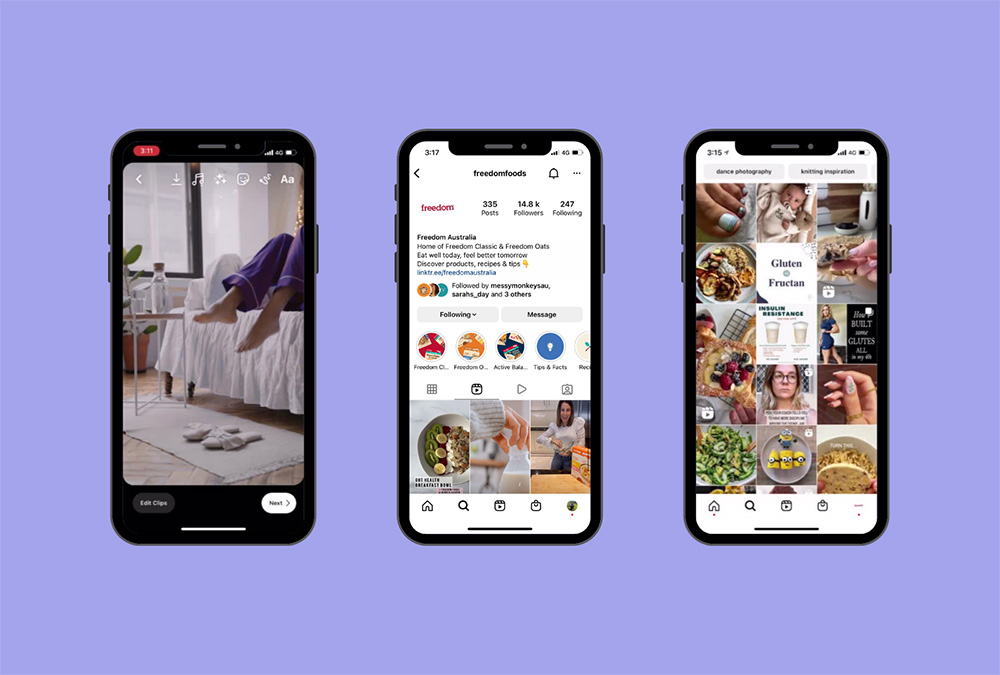There has been a collective resistance to videos and Reels over the last few years.
We get it, videos are generally harder and more time consuming to put together.
But…the time has come, friends, to embrace this new Instagram world, which means incorporating a lot more video in your marketing content.
The truth is Instagram isn’t exclusively a ‘photo sharing platform’ anymore. The days of the beautifully curated feed, square static images, and gasp the Valencia filter (anyone remember this one?) have been over for a while. *sad face*
In mid 2021, Head of Instagram Adam Mosseri made headlines announcing Instagram was “no longer just a square photo-sharing app” and the team were leaning into more entertainment-style content (in line with TikTok), and immersive mobile-first video.
A year on, with short-form video well and truly taken over, it’s evident the algorithm is prioritising video content over static.
So, what does this mean for your brand? How can you best utilise this medium and stand out amongst all the noise online?
Reels – Yes, you *reely* do need to do them
First off, we must talk about Reels.
Yes, you do need to do them. But we urge you not to jump on the trend train and post Reels for the sake of old-mate algorithm.
There is a risk a brand takes when they post Reels to “keep up” with what other accounts are doing, because if your content isn’t on-brand, and if it’s the same as everyone else, it’s doing you a disservice.
The Reels you post need to be strategic and, importantly, be aligned with your brand image.
Too many times we have seen accounts post reels that are not visually on brand, or the audio or music chosen to accompany the video are jarring to the brand voice, the industry they’re in, or services and products provided.
When planning your Reel content, we encourage you to think about the value that this delivers and ask yourself ‘is this consistent with your brand image?’.
Hot little tip: Make sure you post your Reel to your feed and story to maximise reach.

Video posts vs reels?
Now, with all of these options at your fingertips, you may be wondering if you should be posting a video as a post or Reel.
It’s a question we get asked all the time. Ultimately, your decision will boil down to the length and nature of the content.
Reels can be a tidy 90 seconds, where videos (goodbye IGTV) can now be up to 60 minutes long with a 1-minute preview of this in your feed.
The key difference is Reels can be edited natively within the app itself using supplied audio, trending sounds, templates and special effects to jazz it up. They’re designed to be bite-sized and entertaining/helpful.
Reels have now also expanded to Facebook, which means even greater reach if you choose to post on both platforms. And this year, Instagram will also be trialling single image ads that can be converted into video ads and shared via Reels.
Are we sensing a trend?
With all of this change happening, the message is clear: now is the time to embrace all kinds of video, or risk being left behind.



Let’s talk strategy
So, what does this all mean for your strategy in 2022 and beyond?
Should you be focusing on videos/Reels only now? What about photos, quotes, and graphics that might usually be on high rotation?
Historically, Instagram has been defined by the feed. Marketing strategies were centred on curating an aesthetic-pleasing grid filled with inspiring static images and on-brand graphics.
Then came Stories, and we all adapted to that and how to differentiate feed content from Stories.
Now, your Instagram strategy needs to have a reel/video-first approach, with feed posts and Stories to follow.
Static images have their place, for sure. In fact, they’re still extremely important for many brands to promote their products and services.
However, Reels, videos and animated posts should be a focus (not an afterthought) for your marketing strategies moving forward.



